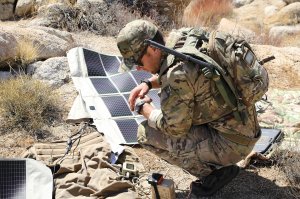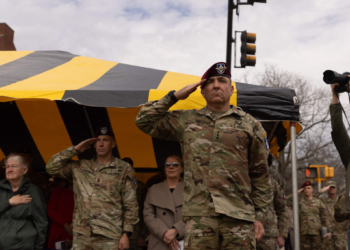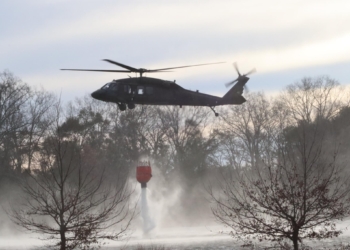When it comes to tackling real-world ramifications of climate change, the Army has big goals for the next three decades. Those aims, including electrifying Army vehicles and reducing Army-caused greenhouse gas emissions by half, were laid out during a recent media roundtable.
Paul Farnan, principal deputy assistant secretary of the Army for installations, energy and environment, told reporters the new strategies will not detract from the Army’s national defense mission. Instead, he said, they will reinforce it.
READ: SecDef puts climate crisis, rebuilding alliances on military to-do list
“I think what people are going to see is one, the growing recognition that climate change is, in fact, a threat to our nation’s security, and it is in fact impacting how and where we operate,” he said. “Every one of these steps is going to increase the effectiveness of our fighting force.”
Concrete steps
Coinciding with the media briefing, Army leaders released a 20-page document describing the branch’s inaugural “Climate Strategy” containing those steps. The strategy details three “lines of effort,” or areas of concentration, including Army installations, acquisition and logistics and training. Each one has its own set of goals, some stretching as far as the year 2050.

“For today’s soldiers operating in extreme temperature environments, fighting wildfires and supporting hurricane recovery, climate change isn’t a distant future, it is a reality,” wrote Secretary of the Army Christine Wormuth in the document’s intro. “We have a unique opportunity to improve our defense capabilities and become a more efficient force, while securing a better future.”
The impetus for the Climate Strategy, Army leaders said, is clear: as the planet experiences changes in temperature and precipitation levels, environmental and social systems also experience rippling upheaval. Take droughts and floods — as certain areas suffer from lack of or too much water, competition for available resources increases. Such events could lead to armed conflicts, greater inequality and crumbling governments. It may also lead to increased disaster response, as storms hit with greater severity and length.
The first line of effort, Farnan said, will be Army posts. If soldiers can ready each of the 130 Army installations for climate change, it will be better equipped for its primary goal of national security. To that end, installation goals include fielding an all-electric, light-duty, non-tactical vehicle fleet by 2027, installing a microgrid on every base by 2035, and reaching net-zero base-caused greenhouse gas emissions by 2045.
Secondly, the Army plans to tackle climate change challenges via the logistical side. Goals include drastically reducing operational energy and water usage and developing charging capabilities to meet the needs of incoming electric vehicles. Lastly, Army leaders hope to train soldiers on the topic, shooting for increased hires with “advanced credentials on climate change topics,” among other aims.
Industry partners
Farnan labeled the steps “not drastic changes” from what the Army is already doing. So far, everything is in the planning stage, with no incoming government funding or even estimated price tags. Farnan called that aspect of the strategy “a moving target.” He also appeared unconcerned about a possible future change in administration, saying that the Army’s improvement would “speak for itself.”
Farnan hopes the Army will soon partner with leaders in the energy and environmental industries — such partnerships would play at least part of the financial puzzle.
“We’re going to be creative,” he said. “We’re going to look at every way to stretch the dollars.”
The alternative ― ignoring climate change to save money ― is no longer an option, Farnan said, especially for America’s military.
“In addition to defending this nation on the battlefield,” he said, “we also need to be good stewards of our environment and our resources here at home.”
Read comments







































